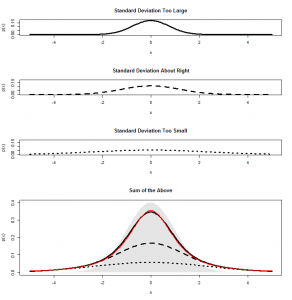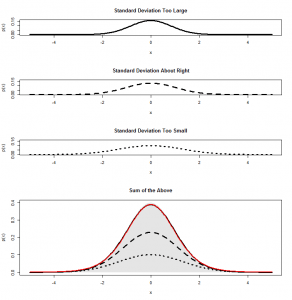In my last post, I talked about how sample means tend to be normally distributed, but if we divide them by their sample standard deviation they are t-distributed. That post was really written as a supporting post for this one, and I’ll assume that you have read that post or understand these things already. Here I’ll show you a little experiment that will give you a pretty good idea of exactly how the -distribution gets its shape.
So, we’re using our sample standard deviation as an estimate of the population standard deviation. What we get then isn’t normally distributed any more because the sample standard deviation will come out different for every sample we pick:
Sometimes it will be a bit too high, which will mean we’ll be dividing our mean by a standard deviation that is too large, and our “-scores” will be “shrunk” compared with what they should be; in the top panel below I have divided by a standard deviation that is too high, so our normal distribution is squashed compared with that of a true
-statistic. Sometimes our estimate of the standard deviation will be too low, and the reverse will happen: our
-scores will be stretched by having been divided by too-small a standard deviation (the third panel below). The second panel is where it is about right. Since these are all divided by a single constant standard deviation, each is still normally distributed:
Since a distribution is like a “pile” of probability mass for any given score, we can combine all these possibilities by piling each pile on top of the other, and this is what I have done in the bottom graph above. The thick black line represents the top of the pile, the sum of all three of our normal distributions. The red line is a -distribution. It’s pretty close, though not exactly right–and that’s because I’m approximating by saying it will be only one of three possibilities: there are many different shades of “too high” or “too low”. But this should give you a decent idea of how the t-distribution gets its shape. The grey-shaded region is the normal distribution, which you can see is quite a different shape.
At the bottom I’ve copied my R code for generating the above plots, in case you’d like to play with it. If we increase our degrees of freedom, for example, by changing to df=10, we can see why the -distribution starts to look like a normal distribution with higher degrees of freedom: because the sample standard deviation gets closer to the right answer, and the normal distributions we are adding up start to look more and more similar:
Since we’re adding up a bunch of normal distributions that all look very similar, it’s no surprise that what we get at the end is something that looks like a normal distribution: the thick black and red lines both match the grey shaded normal distribution pretty closely.
The goal of this post is to show you that a t-distribution is just a pile of different normal distributions with different spreads. And, in fact, one way to derive the shape of the t-distribution is to add up the infinite number of different normal distributions that we could get for every different “wrong” standard deviation that we could get.
Here’s the code:
# tweak the degrees of freedom here
df = 2
# you can tweak this number if you want to explore non-central t-distributions
# the approximation I'm using falls apart a bit for very large ncp (>2), though
ncp = 0
# get standard errors that are too small, about right and too large
plotnames = c("Standard Deviation Too Small", "Standard Deviation About Right", "Standard Deviation Too Large")
SEs = sqrt(qchisq(c(1,3,5)/6,df)/df)
# plot the individual normal distributions
layout(c(1,2,3,4,4))
xs = seq(-5,5,length.out=300)
plots = sapply(SEs,function(SE)dnorm(xs,mean=ncp/SE,sd=1/SE)/3)
sapply(3:1,function(n)plot(xs,plots[,n],type="l",lwd=3,lty=4-n,ylim=c(0,max(plots)),xlab="x",ylab="p(x)",main=plotnames[n]))
# plot these normal distributions piled on top of each other
stackedplots = apply(plots,1,cumsum)
matplot(xs,t(stackedplots),type="l",lwd=3,col="black",ylim=c(0,dnorm(0)),xlab="x",ylab="p(x)",main="Sum of the Above",lty=3:1)
polygon(xs,dnorm(xs,ncp),col=rgb(0,0,0,.1),border=NA)
lines(xs,dt(xs,df,ncp),col="red",lwd=2)

